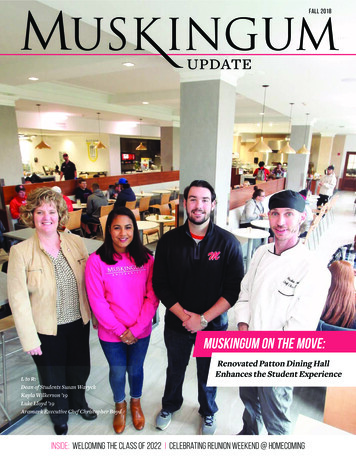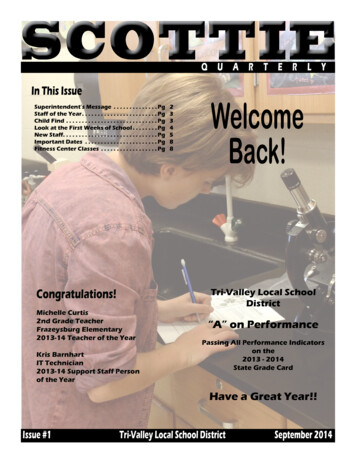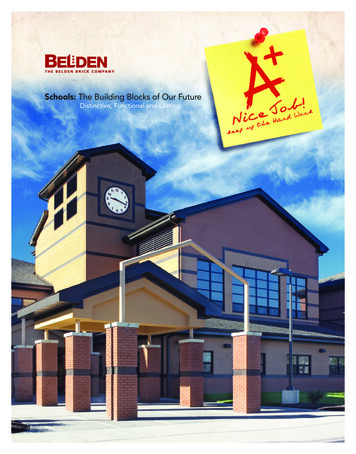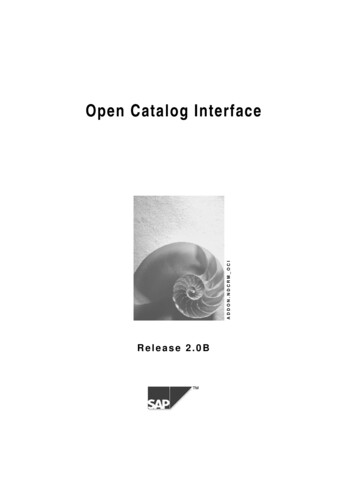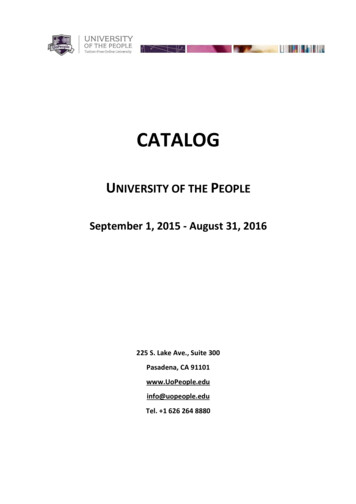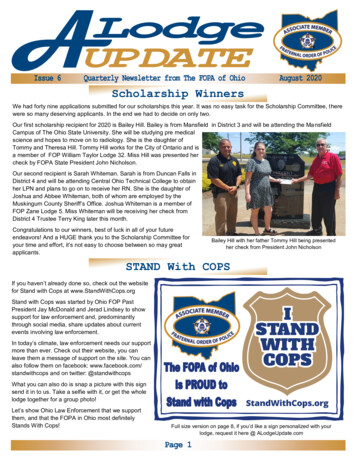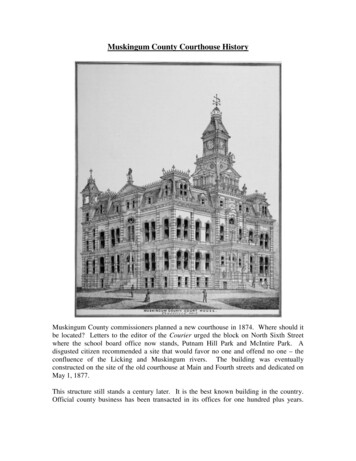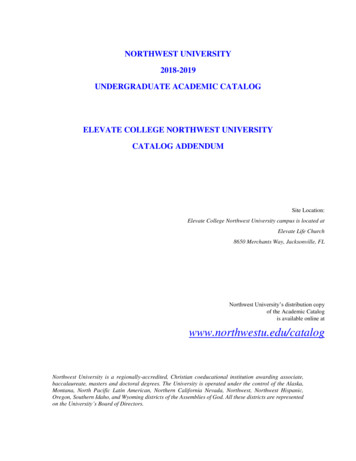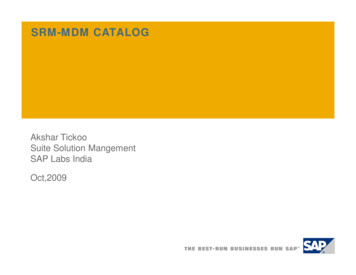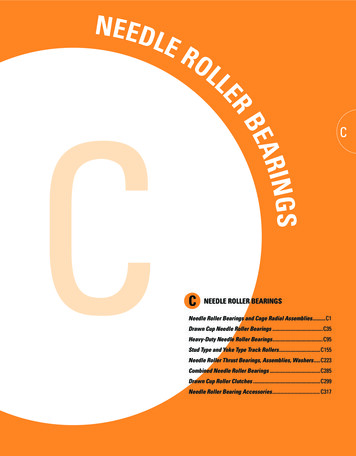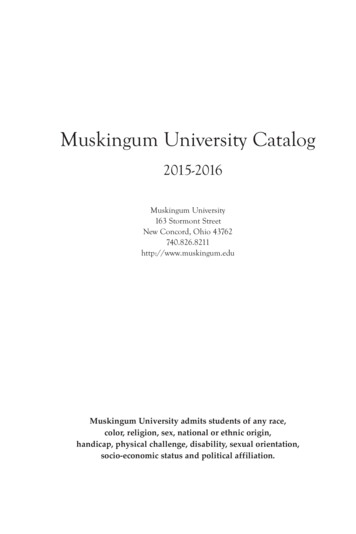
Transcription
Muskingum University Catalog2015-2016Muskingum University163 Stormont StreetNew Concord, Ohio 43762740.826.8211http://www.muskingum.eduMuskingum University admits students of any race,color, religion, sex, national or ethnic origin,handicap, physical challenge, disability, sexual orientation,socio-economic status and political affiliation.
ContentsAcademic Calendars . Inside Front and Back CoversMuskingum University Profile . 3General Information . 6Admission . 17Campus Life . 32Academic Information . 40Academic Programs . 58Board of Trustees . 215Administration . 216Faculty . 224Index . 234The 2015-2016 Muskingum University Catalog describes the program that willbe offered by the University in this academic year. Every effort has been madeto reflect the Muskingum University program, policies and procedures in thisCatalog. The University reserves the right to change, without notice, rules,policies, fees, curricula, courses, or other matters. Any course may be closed atany time because of limited resources, or canceled for reasons beyond theUniversity’s control, such as faculty unavailability or enrollment insufficiency.
Muskingum Profile / 3Muskingum University ProfileDegrees: Bachelor of Arts; Bachelor of Science; Bachelor of Science in Nursing;Master of Arts in Education; Master of Arts in Teaching; Master ofInformation Strategy, Systems, and Technology; Education SpecialistExpenses* **:Undergraduate Expenses for Two Semesters (2015-2016):Tuition . 25,080Room ( 5,230) and Board ( 4,960) . 10,190Matriculation ( 250) and Student Activities ( 236) . 486Technology ( 460), and Laundry ( 156) . 616*Adult undergraduate degree completers should refer to the MAP Guidebook.**Graduate students should refer to the Graduate Catalog.Admission Requirements*:Recommended:Undergraduate:15 units of secondary school4 units English2 units foreign language3 units college prep math2 units science3 units social science1 other units approved by accredited high school*Adult undergraduate degree completers should refer to the MAP Guidebook.Admissions Programs: Early Admissions, Advanced Placement, TransferStudents, and Rolling Admission PlanEnrollment: 1,724 undergraduates (Fall 2014), over 1,200 students takinggraduate classes (2014-2015).Faculty: 95 full-time, 97% with terminal or advanced professional degrees, 13:1student-faculty ratioLibrary: The Roberta A. Smith Library plays a major part in the academic life ofstudents. The library offers students easy access to 50 million items through theintegrated statewide shared OhioLINK catalog of books, DVDs, CDs, and more.Included in the holdings are 140,000 locally held volumes; 130,000 e-books; over46,000 full-text e-journals; more than 125 research databases; and thousands ofimages, sounds, and videos. The library subscribes to Films on Demand, givingstudents access to over 20,000 titles and over 230,000 video segments. Libraryservices to Muskingum students, faculty, and staff include borrowing privilegesat 90 academic libraries and several public libraries throughout the state ofOhio. As a Federal Depository Library of Ohio’s Sixth Congressional District,the Muskingum University Library receives electronic and print governmentpublications from the United States government and the State of Ohio.
4 / Muskingum ProfileA link to the Library resources is available from the University’s website.For direct access to the Library resources, go to http//www.muskingum.edu/library/.The Roberta A. Smith Library is a member of OPAL (Ohio Private AcademicLibraries) and OhioLINK. Thus, in addition to 90 public and private academiclibraries in Ohio, library patrons may also access the Cuyahoga County PublicLibrary, the Westerville Public Library, and the State Library of Ohio. Libraryitems not owned by Muskingum can be requested through OhioLINK and willbe delivered to campus within two to three days.Library instruction classes are offered throughout the semester to helpstudents learn how to use electronic and print resources more effectively forresearch. Students can also receive individualized help with research bystopping by the Reference Desk.Campus: 245 acres with 22 major buildingsLocation: New Concord; 125 miles south of Cleveland, 70 miles east of ColumbusUndergraduate Majors: Accounting (Public), Accounting, American Studies,Art, Athletic Training, Biology, Business Management*, Chemistry, Childand Family Studies, Christian Education, Communication, CommunityHealth and Wellness*, Computer Science, Conservation Science, CriminalJustice, Digital Media Design, Early Childhood Education*, Earth Science,Economics, Engineering Science, English, Environmental Science, French,Geology, German, Health Administration, Health and Fitness, HealthEducation, Health Science*, Healthcare Management*, History, HumanResource Management*, Humanities, Information Systems*, InternationalAffairs, International Business, Journalism, Marketing*, Mathematics,Media Production, Medical Laboratory Studies*, Middle ChildhoodEducation*, Molecular Biology, Music, Music Education, Neuroscience,Nursing*, Organizational Communication, Petroleum Geology, Philosophy,Physical Education, Physics Education, Physics, Political Science,Psychology, Public Administration, Public Affairs, Public Health Studies,Public Relations, Religion, Self-Designed, Sociology, Spanish, SpecialEducation, Sport and Fitness Science*, Theatre*Adult undergraduate degree completers should refer to the MAP Guidebook.Undergraduate Teacher Licensure*: Early Childhood, Middle Childhood,Adolescent/Young Adult, Multi-Age Health and Physical Education,Multi-Age Foreign Language, Multi-Age Music, Multi-Age Visual Arts,and Intervention Specialist, Mild/Moderate (ages 5-21)*These programs have specific requirements for admission.Graduate Teacher Licensure*: Early Childhood (initial licensure); EarlyChildhood (second licensure); Middle Childhood; Adolescent/YoungAdult; Early Childhood Intervention Specialist; Intervention SpecialistMild/Moderate (initial licensure); Intervention Specialist Mild/Moderate
Muskingum Profile / 5(second licensure); Intervention Specialist Moderate/Intensive (initiallicensure); Intervention Specialist Moderate/Intensive (second licensure);Intervention Specialist Talented and Gifted; Principal, Grades PK-9;Principal, Grades 4-12; Early Education of the Handicapped (validation);Early Childhood Development (validation); Reading (endorsement);Talented and Gifted Endorsement; Superintendent, Administrative Specialist(various)*These programs have specific requirements for admission.
6 / General InformationGeneral InformationMissionThe mission of Muskingum University is to offer quality academic programsin the liberal arts and sciences in the setting of a residential, coeducational,church-related university and in the context of a caring community whereindividual fulfillment is encouraged and human dignity is respected. Itsprimary purpose is to develop—intellectually, spiritually, socially andphysically—whole persons, by fostering critical thinking, positive action,ethical sensitivity and spiritual growth, so that they may lead vocationallyproductive, personally satisfying and socially responsible lives.LocationMuskingum University, located in east-central Ohio, is easily accessible bymajor east-west and north-south highways. The Village of New Concord,Muskingum’s home town, is located on US 22 and 40, along Interstate 70, 115miles west of Pittsburgh and 70 miles east of Columbus. U.S. Interstates 77 and70 intersect ten miles east of New Concord near Cambridge; Zanesville issixteen miles to the west.HistoryChartered in 1837 as Muskingum College, Muskingum University is rich intradition, its proud heritage reaching back to the first half of the nineteenthcentury when Ohio was an infant state and covered wagons were bringingadventurous settlers westward through New Concord over the newly-completedNational Road. The institution’s Indian name, sometimes mispronounced andoften misspelled, is a source of pride to those who cherish the history of thatcolorful part of frontier America “beyond the Alleghenies.”During its first half-century, Muskingum adhered to the educationalpatterns of the classical college of the period. In 1854, women were admittedon an equal basis with men. After the Civil War, a period of steady growthbegan, accelerating until the frontier classical college of fewer than a hundredstudents had evolved into a modern liberal arts and sciences college. Today,approximately 1,700 undergraduates and more than 1,000 graduate studentsstudy on Muskingum’s beautiful 245-acre campus.When Franklin College, an important educational institution of thePresbyterian Church in the 19th century, closed in 1927, its alumni rolls cameto Muskingum.In January 2000, Dr. Anne C. Steele became Muskingum University’s 20thPresident. In 2009, Muskingum acquired university status.Presbyterian HeritageOn March 18, 1837, the state legislature granted a group of New Concordcitizens a charter to establish a college in the Village. Because the communitywas settled largely by farm people of Scots-Irish descent, the predominantreligion was Presbyterian. In 1877, Muskingum became associated with theSynod of Ohio of the United Presbyterian Church. With the merger of thePresbyterian and United Presbyterian churches in 1958, Muskingum became
General Information / 7associated with the newly-created United Presbyterian Church in the USA. In1983, that church merged with the Presbyterian Church in the United States toform the Presbyterian Church (USA). Muskingum’s direct affiliation is with thethree-state Synod of the Covenant.Accreditation and MembershipsMuskingum University has been continuously accredited since 1919 by theHigher Learning Commission (renewed in 2013) and is authorized by, andreceives periodic reauthorization from, the Ohio Board of Regents to grant itsdegrees. The Higher Learning Commission is located at 230 South LaSalle Street,Suite 7-500, Chicago, IL 60604; phone 800.621.7440. The program in chemistryis approved by the American Chemical Society. The Muskingum UniversityEducator Preparation Unit is accredited by the National Council for Accreditationof Teacher Education (NCATE) for both initial and advanced programs.Muskingum University is fully approved for teacher education by the OhioDepartment of Education and is a member of the Interstate CertificationCompact which provides for comparable certification in numerous other statesincluding Pennsylvania, New York and New Jersey. Muskingum University isan accredited institutional member of the National Association of Schools ofMusic. The Nursing programs are nationally accredited by the Commission onCollegiate Nursing Education (CCNE) located at Dupont Circle, NW, Suite 530,Washington, DC 20036, 202.887.6791. The pre-licensure BSN program isapproved by the Ohio Board of Nursing. The Nursing Department also holdsmembership in the American Association of Colleges of Nursing (AACN). TheEngineering Science program is accredited by the Engineering AccreditationCommission of ABET.Muskingum holds memberships in the American Council on Education, theCouncil for the Advancement and Support of Education, the Council ofIndependent Colleges, and the Association of Independent Colleges andUniversities. The University is also a member of the Ohio Confederation ofTeacher Education Organizations (OCTEO).CampusMuskingum’s scenic campus occupies 245 acres of rolling land in the Villageof New Concord. A small lake near the center of the campus is crossed by afoot bridge connecting the academic area on one hill to three of the residencehalls on another. Nearby is the 3500-seat football stadium. Artificial field turfwas added to Sherman Field in McConagha Stadium in 2005. The eight-laneall-weather track was completely renovated in 2012, along with new jump lanesfor long jump and pole vault. In 1986 Muskingum’s recreation center was opened.In 2004 the state-of-the-art Philip and Betsey Caldwell Hall, a communicationarts complex, was dedicated.The Walter K. Chess Center features an elevated pedestrian walkway whichunites the two residential complexes. A new art gallery honors a former artprofessor, Louis Palmer. One of the newest facilities, Fran and Otto Walter Hall,revitalizes the East Campus and houses the Departments of Music, WorldLanguages, and the PLUS Center. Also on the campus are a softball field, abaseball diamond, a number of athletic fields for intramural sports and varsity
8 / General Informationpractice and six tennis courts. The McAllister Biology Station, a 57-acre tract ofland located in nearby Otsego, is used as a biology preserve and study area.Academic FacilitiesA description of the major university facilities follows:The Boyd Science Center (1971) is a four-floor building housing the biology,nursing, chemistry, geology, mathematics and computer science, and physicsand engineering departments, along with the computer and network servicescenter. It has modern facilities and laboratory equipment for undergraduatescience instruction, including proton nuclear magnetic resonance spectrometers,ultraviolet-visible light spectrophotometers, microcomputer-based physics andengineering laboratories, mass spectrometer, infrared spectrophotometer, carbon13 nuclear magnetic resonance spectrometer, x-ray diffraction equipment, animage analysis system and the University’s shared servers, network, voice, andPBX systems. The Science Center was named in memory and honor of ThomasA. and Grace Jean Bethel Boyd, alumni of Muskingum, in 1990. Mr. Boyd wasknown for his research on fuel.Brown Chapel (1912) is a multipurpose building which serves as church, chapel,auditorium, and classroom. Its main auditorium seats 500 and houses an organwhose moveable console permits its use for recitals and church services. Thelower level contains a lounge area, a small chapel and offices for the Departmentof Religion and Philosophy. The chapel was named for J. M. Brown of Wheeling,West Virginia, a benefactor of the university and long-time member of the Boardof Trustees.Philip and Betsey Caldwell Hall (2004) houses the Department ofCommunication, Media, and Theatre. It is a state-of-the-art building that includesclassrooms equipped with advanced information technology, television andradio studios, a 250-seat theatre, an experimental theatre, costume and setdesign laboratories, an exhibit hall, and faculty offices. The building honors theextraordinary legacy of Philip and Betsey Caldwell, lifelong champions of highereducation. A 1940 Muskingum graduate and member of the Board of Trusteesfor 37 years, Mr. Caldwell served as chairman and chief executive office of FordMotor Company. Mrs. Caldwell, a graduate of the University of North Carolina,has participated in many historic restoration and preservation initiatives and,for many years, was a member of the Mount Vernon Advisory Board.Cambridge Hall (1929) was built largely with funds contributed by citizensof nearby Cambridge. Formerly housing the natural sciences, it was remodeledin 1972 for use by the social science division, and remodeled again in 2004 foradditional use by the English department. Along with classrooms, it containsseminar rooms, faculty offices, and student computer laboratories.Walter K. Chess Center (2008) is a student activity center honoring Dr. Walter K.Chess (Class of 1943) and his life-long dedication and generosity to Muskingum.The Center is part of the student residential complex and contains spaces for
General Information / 9study, student meetings and social gatherings, a fitness area, a library annex,food services, and a lounge with resources relating to career planning, studyabroad, internships, and other programs that enhance the educationalexperience of Muskingum traditional undergraduate students. State-of-the-arttechnology links the Center to resources throughout the campus. A pedestrianbridge from the upper level of the facility connects the two major residentialareas of the campus, thus making the Chess Center the hub of student life.Computer, Data, and Voice Facilities are provided through a robust backendand fiber optic infrastructure. Muskingum’s academic quadrangle houses manylabs, totaling over 200 Windows PCs, which are available for student use. Someof these have discipline-specific software for areas of study, including art,theatre, graphic arts, computer science, mathematics, physics and engineering,and psychology. All campus offices and residential rooms are provided withdata and voice services which include internet, local dial tone and voice mail.John Glenn Physical Education Building (1935) was named in 1962 in honorof the distinguished astronaut/senator alumnus. It houses a gymnasium, aswimming pool, and recreational equipment. Extensive renovations in 2007include new locker rooms and state-of-the-art athletic training facilities.The Roberta A. Smith University Library (2015) features student groupmeeting areas with high-tech equipment to enhance student learning andinvolvement. The library is named for Roberta Arndt Poland Smith, whosegenerosity is in tribute to her mother, Margaret Fleming Arndt Poland, Class of1909, and Mrs. Smith's father, Chester Harrison Poland. Margaret Arndt (18891967) of Hanover, Ohio, enrolled at Muskingum over a century ago. This40,000-square-foot facility is accessed through a main entrance atrium leadingto a spacious and light-filled Commons area. To the right, a dramatic two-story,1500-square-foot, glass-walled Colloquium Center incorporates a projectionwall and a fireplace. An expansive and open Grand Staircase connects thebuilding's levels and provides small gathering spaces throughout its widelandings.Providing students with easy access to 50 million items through theintegrated statewide shared OhioLINK catalog of books, DVDs, CDs, andmore, the library is home to several special collections including the Regional,Church and University History Collection, the Children's Literature Collectionand the United States Presidents Collection. Along with three libraryinformation hubs, three reading rooms, and seven classrooms, the library offersstudy space in Interactive Projection Technology rooms designed to supportcollaborative, project-based assignments.In addition to the library operations areas and offices for the Universitylibrarian and library staff, the library houses the offices for Muskingum'sTeacher Preparation Program faculty.Montgomery Hall (1921) the campus administrative hub, contains administrativeand faculty offices and classrooms. It is named for Dr. J. Knox Montgomery, Sr.,President of Muskingum from 1904 to 1931.
10 / General InformationRuth and John Neptune Art Center (2008) honors John (Class of 1942) andRuth Dorsey (Class of 1940) Neptune. Early in his career, Dr. Neptune taughtchemistry at Muskingum and later joined the faculty of San Jose StateUniversity, where he held the H. Murray Clark Chair of Chemistry. Ruth waschair of Muskingum’s Art Department from 1944-48, taught in public schoolsin Wisconsin, and taught painting, watercolor, fiber arts, and mosaicsthroughout her long career in the arts and arts education. The Neptune Centeris dedicated to the teaching of ceramics and sculpture. The facility containsstate-of-the-art studio space, one gas-fired and two electric kilns, andspecialized equipment which supports the work of student artists,photographers, and sculptors.The Louis O. Palmer Art Gallery (2013) is a teaching gallery designed toshowcase the work of Muskingum students, faculty, and guest artists. Thefacility features an expansive central gallery, auxiliary spaces to support artevents, and environmentally-friendly solar panels to help support its electricityconsumption. The Art Gallery was built through the generosity of Muskingumalumni and named in honor and memory of Louis O. Palmer (1915-1997),Muskingum Professor of Art from 1956-1981.Paul Hall (1873) the oldest building on campus, is named for Dr. David Paul,President of the College from 1865 to 1879. Designated a National Historic Site,the building houses art studios, classrooms and faculty offices.The Quad Center (1960), the campus social center, houses lounges, the Bait Shopsnack bar, mail room, campus bookstore, meeting rooms and administrativeoffices, including Student Life.The Recreation Center (1986) connects on all floors with the John GlennPhysical Education Building to provide a complete varsity and intramuralcomplex. Its construction was made possible by the contributions of over 5,000donors to the University’s Design for Tomorrow planning and fundraisingprogram in the 1980s. The facility includes a varsity gymnasium with seatingfor 2,800; two racquetball courts; conditioning and training rooms; a practiceroom for baseball and softball; locker rooms for students, faculty, staff andofficials; an observation lounge; and offices and seminar/conference rooms.Otto and Fran Walter Hall (2011) honors the remarkable lives and generosityof two lifelong champions of justice, education, and the arts. It houses theDepartment of Music, the John and Therese Gardner World Language Center,and the PLUS Center. The music area includes faculty studios, percussion,composition and piano studios, individual practice rooms, a library, a studentlounge and designated recital halls for both vocal and instrumental music. TheWorld Language Center includes a state-of-the-art language laboratory, facultyoffices, and a seminar room. The PLUS Center provides distraction-reducedfacilities for testing, and offices for learning consultants who provide privateone-on-one tutoring with computer access.
General Information / 11The Wellness Center (2002) provides regular physician clinic hours and apharmacy, and treats minor illnesses and injuries. The facilities are available oncampus for undergraduate students.Residence HallsThe majority of students live in the residence halls that are clustered atoptwo hills overlooking the football field, the lake and the Hollow. Finney, Kelley,and Patton make up the East Residence Area. Additionally, a number of moreindependent living areas are located along Lakeside Drive. The West ResidenceArea is comprised of Memorial, Moore, and Thomas Halls, and the Townhouses.Finney Hall (1961) named for the late Harold P. Finney of Cleveland, abenefactor and former chairman of the board of trustees, houses 130 first-yearand upper-class men and women.Kelley Hall (1956) is the largest residence hall on campus and is named forRuth Kelley Montgomery, wife of 1932-1962 Muskingum President, RobertMontgomery. Kelley houses 240 first-year and upper-class men and women.Memorial Hall (1951) was built as a memorial to Muskingum alumni whoserved in World War II. The building accommodates 100 first-year and upperclass women.Moore Hall (1958) housing more than 100 first-year and upper-class men, isnamed for the late Paul M. Moore of Aliquippa, Pennsylvania, a longtimemember of the board of trustees and a benefactor of the University.Patton Hall (1922) reopened in the summer of 1996 after major renovations.Named for Emma Patton Montgomery, wife of John Montgomery, President ofMuskingum from 1904-1931, it houses 120 first year and upper-class students.Thomas Hall (1961) accommodating 150 first-year men and women, is namedfor the late Roger Crile Thomas and his brother, Paul M. Thomas, of Phoenix,Arizona.The Townhouses (1998) are Muskingum's apartment style housing facilities.The 12 suites accommodate 72 students.International EducationMuskingum University intentionally promotes programs that encourage anddevelop international awareness and understanding. Formal student exchangeagreements exist between the University and institutions around the world, witha wide range of additional study abroad opportunities available. The GeneralEducation (gen ed) program requires exposure to international perspectives,and an international faculty and student body add diversity to the campus. Thecurriculum features a significant and growing amount of coursework in foreignstudies, international business, international affairs, and world languages andliteratures.
12 / General InformationMuskingum Adult Program (MAP)The Muskingum Adult Program provides a path for working adults tocomplete a bachelor’s degree by offering a flexible course schedule of online,evening and weekend classes to fit into the busy lifestyle of adult students.MAP students can choose to major in Accounting, Accounting (Public),Business Management (BS), Child and Family Studies, Communication,Community Health and Wellness, Criminal Justice, Early Childhood Education,Health Science, Healthcare Management, Human Resource Management (BS),Information Systems, Intervention Specialist: Mild to Moderate, Marketing(BS), Medical Laboratory Studies, Nursing (RN to BSN completion track), andSport and Fitness Science.Typical MAP courses are at the upper level (300- and 400-level) and aredesigned to provide more advanced professional and academic study forstudents who have completed an associate’s degree or about 60 semester hoursof credit. Students who have earned fewer than 60 credits, however, may stillenter the MAP program. Additional information is available from Graduate andContinuing Studies and the MAP Guidebook available at www.muskingum.edu.PLUS ProgramPLUS Program services include the following: (1) structured and on-goingone-to-one tutorial sessions to enhance student learning and application ofacademic skills; (2) pre-advising to guide students toward a balanced courseload and optimal course selection, thus maximizing the student's potential forsuccess; (3) provision of a Primary Learning Consultant, who acts as a liaisonbetween home, faculty and others; and (4) a continuum of services that providestudents with opportunities for more intense and frequent, but short-term,individualized academic support that may be needed to make academic progress.Students may benefit from the PLUS Program by understanding, appreciatingand developing language with which to talk about their unique learning profiles;developing skills to effectively manage learning; enhancing study skills andstudy support systems; strengthening skills needed to advocate on their ownbehalf; raising self-awareness; uncovering beliefs and attitudes; learning tacticsfor self-regulation; directing and managing their own learning processes; andacquiring life-long learning skills.The PLUS Program is built upon a proven learning strategies instructionalmodel that is blended with a learning conversation method.Highly skilled, adult, professional Learning Consultants/Associates providesystematic and explicit instruction in learning strategies that are embedded incourse content, assist the student in learning and practicing these individualizedlearning strategies and help the student adapt the strategies to other coursesand situations.Learning Consultants/Associates also partner with students and engage inlearning conversations that support students in identifying and understandingthe student’s specific learning strengths and challenges, recognizing the factorsthat influence the student’s success and acquiring friendly tools with which tomanage learning challenges. These conversations are also designed to empowerstudents by guiding them in acquiring a foundational knowledge of the
General Information / 13learning process, the language with which to discuss it, and the tools withwhich to manage their own learning.This blended model assists students in strengthening skills in areas such astime and materials management, organization, memory, reading, writing, exampreparation and study skills, while also assisting students in learning and usingtools that raise their self-awareness; building and using effective learning supportsystems; employing tools that support higher order thinking and self-regulation;and fostering self-advocacy skills so students know and get what they need tosucceed. Although these are often areas of challenge for students with LDand/or ADHD, it is essential that students know and effectively use suchindividualized learning strategies and self-management tools to meet therigorous academic demands of the University.Through constructing friendly learning environments that incorporate andbuild upon student strengths and minimize the effects of their learning challenges,the Plus Program enables students to build self-confidence and to become lifelong learners, essential attributes for success in college, work and life pursuits.When such vital knowledge, language, skills, strategies and tools areobtained in a supportive environment, and time and opportunities are allowedfor the st
The Nursing programs are nationally accredited by the Commission on Collegiate Nursing Education (CCNE) located at Dupont Circle, NW, Suite 530, Washington, DC 20036, 202.887.6791. The pre-licensure BSN program is approved by the Ohio Board of Nursing. The Nursing Department also holds membership in the American Association of Colleges of .
